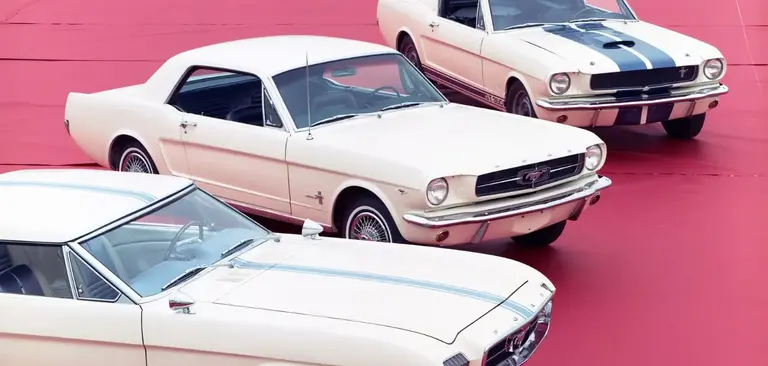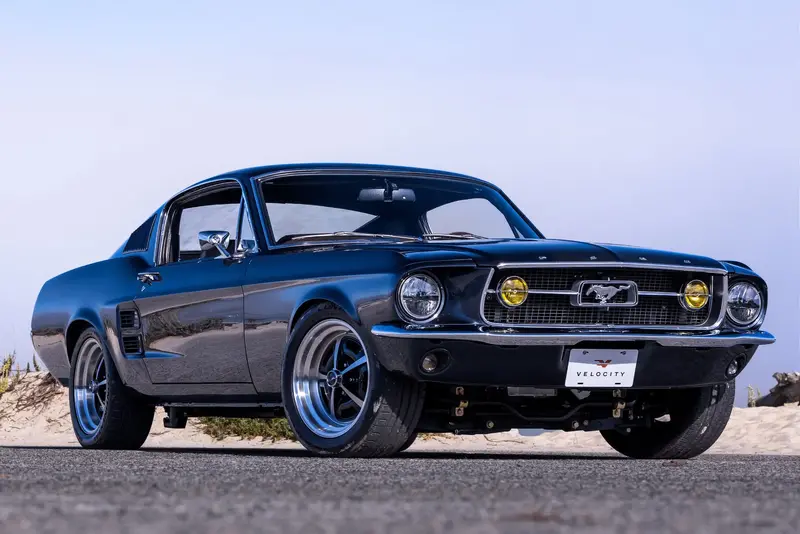Ford recently celebrated the 60th anniversary of its legendary Mustang, which ironically took place just months after the Chevrolet Camaro and Dodge Challenger rivals were discontinued. These two events showcase the volatility of the sports car market in the U.S. as well as highlight the Mustang’s resilient legacy. Although the Plymouth Barracuda beat the Mustang to production back in 1964, the Mustang (and its dominating sales) are credited with sparking the Pony Car segment.
Keep reading to learn more about the history of the Ford Mustang.
Small Car + Small Price = Huge Demand
As more Americans were moving to the suburbs, they were also adding a second vehicle. The number of two-car families ballooned from just one million in 1959 to 13 million in 1963, and to cash in on this trend, Lee Iacocca had proposed a new small car that focused on value and youthfulness. To save development time and production costs, the Mustang shared parts with the Ford Falcon.
Three concept vehicles were created during the development of the production Mustang, and these were the 1962 Mustang I, 1963 Mustang II, and 1964 Allegro. The 1965 Ford Mustang made its official debut at the World’s Fair in New York on April 17, 1964.
Focusing on value, the 1965 Ford Mustang had a starting price of just under $2,500, which was one of the factors that contributed to frenzy of buyers and enthusiasts at Ford dealerships following the car’s public debut. This popularity translated to massive sales with the Mustang beating Ford’s projected first-year sales forecast in less than four months, and the one millionth Mustang rolled off the assembly on March 2, 1966, less than two years after the car’s debut. For comparison, it took the Camaro six years to accomplish that same production milestone. Two years later, Iacocca drove the two millionth Mustang - a red 1968 Mustang coupe - off the assembly line; that feat took the Camaro 12 years to accomplish!
With that kind of success, it’s no wonder that the Mustang has been immortalized in movies such as Bullitt, Gone In 60 Seconds (both the 1974 original and 2000 remake), Need For Speed, and so many more.
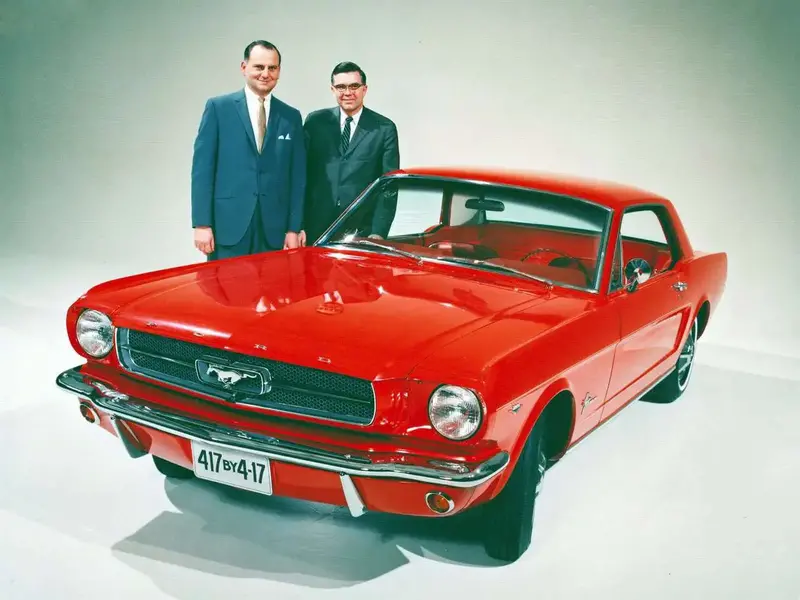 Lee Iacocca (left) and Don Frey (right) posing with a 1965 Ford Mustang | Credit: Ford
Lee Iacocca (left) and Don Frey (right) posing with a 1965 Ford Mustang | Credit: Ford
First Generation 1965-1973
A key item to note when discussing this first-generation body style is that while you’ll hear people mention a 19641/2 Mustang, all Mustangs started production for the 1965 model year. That being said, there are some details that distinguish the early builds. The Mustang went through quite an evolution from its launch until 1973, but all were available in the hardtop, convertible, or fastback body styles.
Of the first million Mustangs sold, 755,000 were hardtops, 142,000 were convertibles, and 103,000 were fastbacks. More importantly, the Mustang managed to attract a younger demographic with a median age of 31, and 35% of these buyers were single and 42% were female.
1965-1966
The early 1965 Mustangs (referred to as 19641/2 Mustangs by enthusiasts) were powered by 170-cubic-inch inline-six, a 260-CID V8, or a 271-hp 289-CID V8. Later in the production run, the smaller engine options were replaced by a 200-cid inline-six and a detuned version of the 289 featuring a two-barrel carb; V8s outsold V6 models by a 2:1 margin.
The Mustang was available with an optional GT trim level that would later become a staple for the Mustang, and it didn’t take long for Carroll Shelby to get his hands on the Mustang to create the Shelby GT350.
1967-1968
For 1967, the Mustang grew in size, and these Mustangs are easy to identify thanks to the concave taillight design. The larger size allowed for more passenger and cargo space, but the key reason for the growth was to create space under the hood for a big-block V8. New engines included 390, 428 Cobra Jet, and the 302, the latter of which eventually replaced the four-barrel 289. This model year range delivers what can be argued as the best balance of looks and performance, which is why it is the chosen body style for the Velocity Ford Mustang.
1969-1970
The Mustang grew again in 1969, and it added now-legendary nameplates such as the Mach 1, Boss 302, and Boss 429; the Mustang GT was dropped in 1969 and the fastback body style was now referred to as a SportsRoof. Likewise, the engine lineup grew with an additional six-cylinder engine (a 250-CID inline-six), the 351, and the 375-hp 429. The 1970 Mustang is easy to identify with its headlights now inside the grille and stacked air inlets situated between the headlights and fenders.
1971-1973
This model year range of Mustang marked the furthest departure from the original Mustang in terms of styling but also in size as it was eight inches longer and six inches wider than the 1965 model. Engine options whittled down to just the 250 inline-six, 302 V8, 351 V8, and 429 V8, which was dropped after 1971.
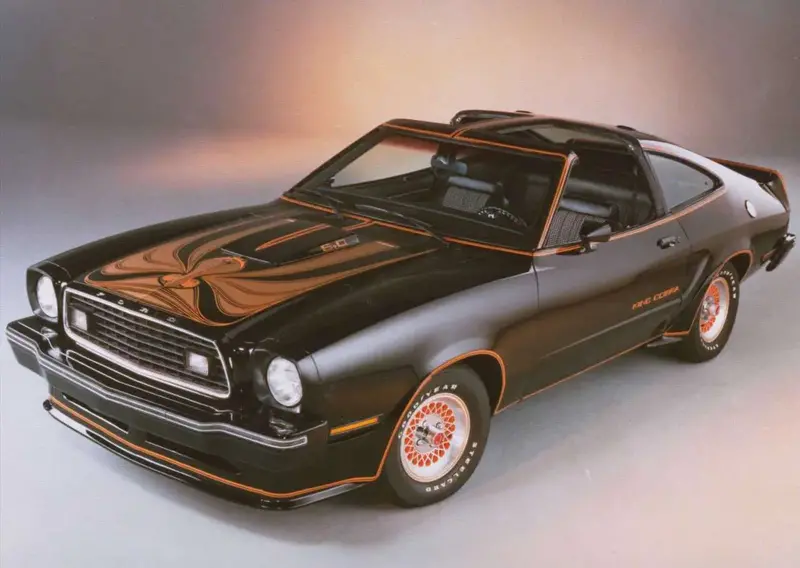 1978 Ford Mustang II | Credit: Ford
1978 Ford Mustang II | Credit: Ford
Second Generation 1974-1978
As the Mustang continued to grow in size, Iacocca had pushed for the return of a smaller Mustang. This decision would end up being a fortuitous coincidence as the downsized Mustang II debuted just before the 1973 Oil Crisis, which sent many automakers scrambling to produce smaller vehicles. The 1974 model year is unique in that it stands as the only Mustang ever to not offer a V8 engine, as first-year engine options were limited to the 140-CID inline-four and the 171-CID V6. The 302 V8 did return for 1975 with a 5.0L designation, and this 140-hp V8 was the only engine available in the 1978 King Cobra.
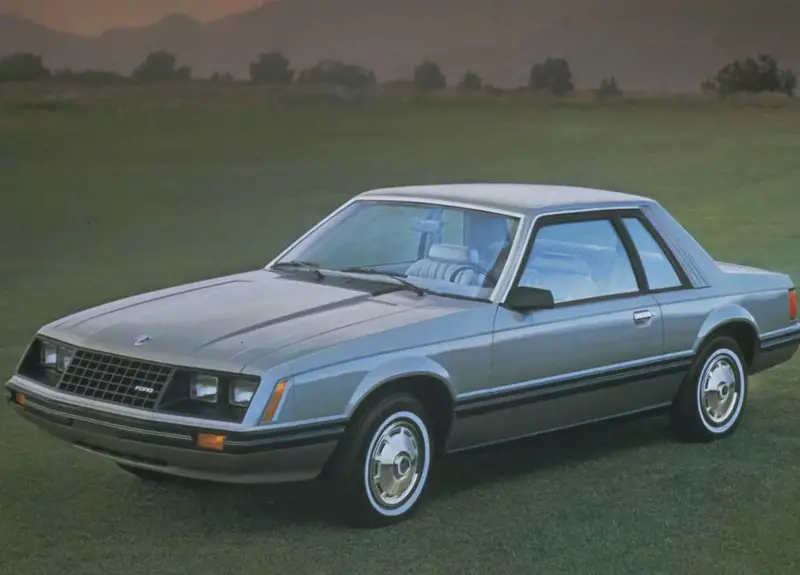 1979 Ford Mustang | Credit: Ford
1979 Ford Mustang | Credit: Ford
Third Generation 1979-1993
The Fox Body Mustang (named after the Fox platform shared with other Ford products like the Ford Fairmont and Mercury Cougar). This generation of the Mustang saw the use of various engines including four-cylinders (turbocharged and naturally aspirated), six-cylinders (inline and V6), and of course V8s. The 5.0 launched in 1979, was replaced by the 4.2L V8 in 1980-81, and then returned in high-output form in 1982. The reintroduction of the 5.0L V8 coincided with the return of the Mustang GT, and a year later, the Mustang convertible joined the notchback and hatchback body styles.
Notable models for the third-generation Mustang include the police-ready Mustang SSP in 1982, turbocharged Mustang SVO from 1984-1986, and high-performance versions called the SVT Cobra and Cobra R in 1993. The aerodynamic shape used on the SVO inspired the Mustang’s redesign in 1987. It’s interesting to note that three generations of the Chevrolet Camaro/Pontiac Firebird were produced during the 14-year lifespan of the Fox Body Mustang.
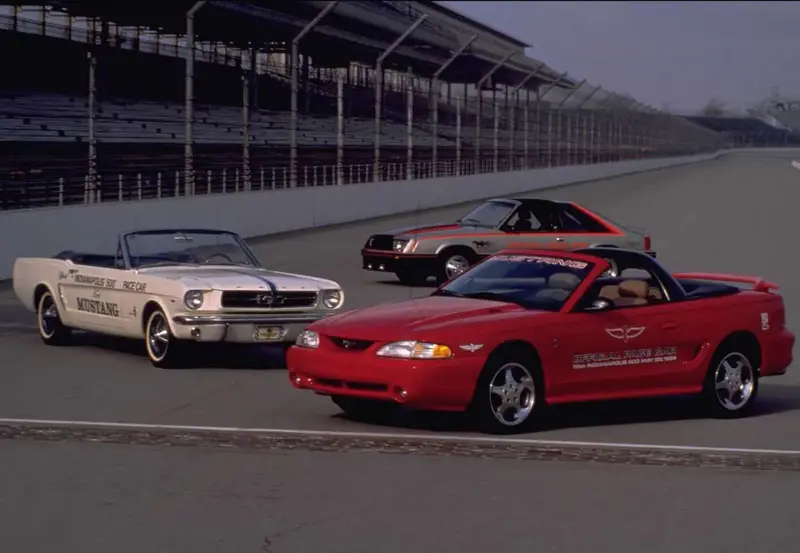 1994 Ford Mustang SVT Cobra Indy 500 Pace Car | Credit: Ford
1994 Ford Mustang SVT Cobra Indy 500 Pace Car | Credit: Ford
Fourth Generation 1994-2004
For its fourth generation, the Mustang ditched the notchback body style, but brought back classic Mustang design cues such as the dual-cowl dash and the three-bar taillights. In 1996, the GT’s 5.0L V8 was replaced by Ford’s 4.6L V8, but power output increased from 215 hp in 1994 up to 260 hp in 2004.
The Mustang was redesigned in 1999 with the New Edge design language, and this same year, the SVT Cobra returned, marking the first time a Mustang featured an independent rear suspension setup. The Mustang Bullitt debuted in 2001 as a salute to the 1968 Steve McQueen film, and two years later, the Mustang Mach 1 debuted with its Shaker hood.
This generation was the last of the Mustangs to be built at Ford’s Dearborn Assembly Plant as Mustang production moved to the Flat Rock Assembly Plant for the fifth and subsequent generations.
Fifth Generation 2005-2014
The design team went full retro for the fifth-generation Mustang pulling heavy influence from the original body style such as the exposed headlights, fog lights in the grille, the coupe’s fastback-style roof, and the three-bar taillights flanking a faux gas cap. The 4.0L V6 and 4.6L V8 were the only engines available until the Shelby GT500 debuted for 2007 with a supercharged 5.4L V8.
The 2011 model year saw the return of the 5.0L thanks to the Coyote V8, which is the same engine family used in the Velocity Ford Mustang, Velocity Ford Bronco, Velocity Ford F-100, and Velocity Ford F-250. Ford brought back the Bullitt Mustang for 2008-09, and the legendary Boss name returned in 2012 on the Boss 302 and Boss 302 Laguna Seca.
Sixth Generation 2015-2023
The debut of the sixth generation aligned with the Mustang’s 50th anniversary, but rather than look to the car’s past, this redesign was all about creating a modern Mustang. From its sleek styling to its new turbocharged four-cylinder engine and independent rear suspension, this Mustang was more advanced than ever. The 3.7L V6 was dropped in 2018, but the Gen III 5.0L Coyote V8 now produced 460 hp. The GT500 returned in 2020 with an incredible 760 hp from its 5.2L supercharged V8. In August 2018, Ford celebrated the production of the 10 millionth Mustang.
Seventh Generation 2024-Present
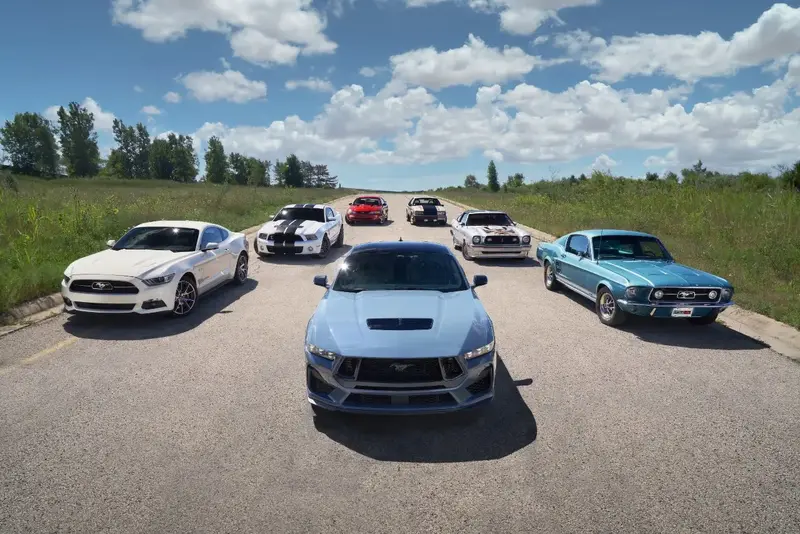 All six generations of the Ford Mustang together. | Credit: Ford
All six generations of the Ford Mustang together. | Credit: Ford
The current version of the Ford Mustang was introduced for 2024 and went into production in May 2023. Revealed just months before it was announced that the Dodge Challenger and Chevrolet Camaro were being discontinued, this Mustang could very well be the last pony car. Among its highlights, this Mustang features the Gen IV Coyote V8 producing up to 500 hp in the Mustang Dark Horse, and Ford also introduced the ultimate Mustang, the street-legal, race-inspired Mustang GTD with more than 800 hp and a rear-mounted transaxle!
Velocity and the Ford Mustang
In 2023, we launched the Velocity Ford Mustang that boasts a Gen III 5.0L Ford Coyote V8 and Roadster Shop Spec chassis to deliver an exhilarating drive. Based on the 1967-1968 Ford Mustang, our modernized classic debuted with a Fastback body style, and, in 2024, Velocity introduced the new Convertible Package for classic car enthusiasts who desire open-air driving.
Discover the thrill of driving a classic Mustang with all the reliability and comfort of a modern vehicle. Visit our Mustangs for Sale page to explore our available models and find your dream car today. Don’t miss out on the opportunity to own a piece of automotive history, reimagined for today’s discerning driver. Contact us now to learn more and schedule a test drive.
Own a legend. Drive a Velocity Ford Mustang.
